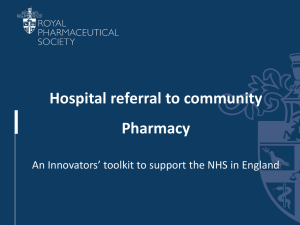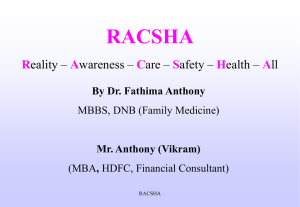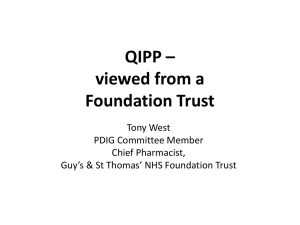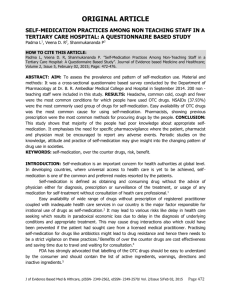INTERVENTIONAL STUDY ON SELF MEDICATION IN
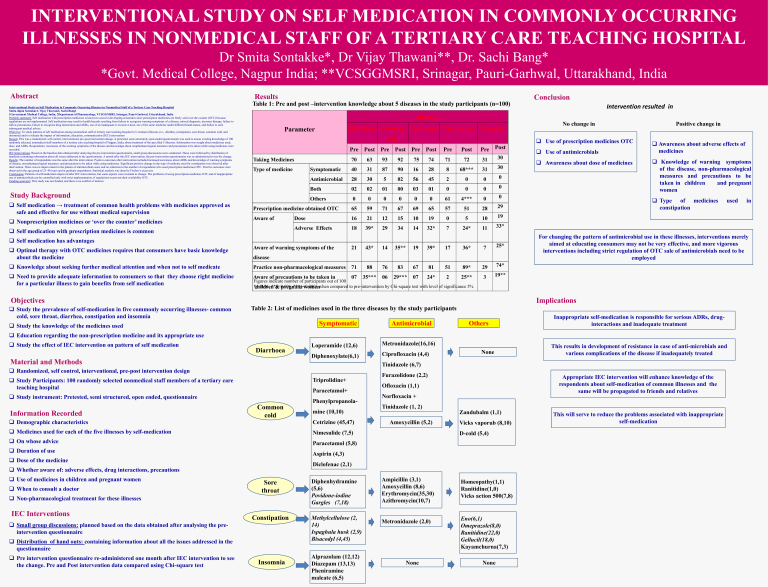
INTERVENTIONAL STUDY ON SELF MEDICATION IN COMMONLY OCCURRING
ILLNESSES IN NONMEDICAL STAFF OF A TERTIARY CARE TEACHING HOSPITAL
Dr Smita Sontakke*, Dr Vijay Thawani**, Dr. Sachi Bang*
*Govt. Medical College, Nagpur India; **VCSGGMSRI, Srinagar, Pauri-Garhwal, Uttarakhand, India
Abstract
Interventional Study on Self Medication in Commonly Occurring Illnesses in Nonmedical Staff of a Tertiary Care Teaching Hospital
Smita dipak Sontakke1, Vijay Thawani2, Sachi Bang1
1Government Medical College, India; 2Department of Pharmacology, VCSGGMSRI, Srinagar, Pauri-Garhwal, Uttarakhand, India
Problem statement: Self medication with prescription medicines is known to occur in developing economies since prescription medicines are freely sold over the counter (OTC) because regulations are not implemented. Self medication may result in health hazards resulting from failure to recognize warning symptoms of a disease, missed diagnosis, incorrect therapy, failure to follow precautions, failure to recognize drug interactions and ADRs, use of an inadequate or excessive dose, use of the same medicine under different brand names, and failure to seek subsequent medical advice.
Objective: To study patterns of self medication among nonmedical staff of tertiary care teaching hospital in 5 common illnesses (i.e., diarrhea, constipation, sore throat, common cold, and insomnia) and to evaluate the impact of information, education, communication (IEC) intervention
Design: This was a randomized, self-control, interventional, pre-post intervention design. A pretested, semi-structured, open-ended questionnaire was used to assess existing knowledge of 100 randomly selected, nonmedical staff members of a tertiary care teaching hospital of Nagpur, India, about treatment of the specified 5 illnesses. Information was sought about medicines used, dose, and ADRs. Respondents‘ awareness of the warning symptoms of the disease and knowledge about nonpharmacological measures and precautions to be taken while using medicines were recorded.
IEC Interventions: Based on the baseline data obtained after analyzing the pre-intervention questionnaire, small group discussions were conducted. These were followed by distribution of handouts containing information about all issues addressed in the questionnaire. A month after this IEC intervention, the pre-intervention questionnaire was re-administered to see the change.
Results: The number of respondents was the same after the intervention. Positive outcomes after intervention included increased awareness about ADRs and knowledge of warning symptoms of disease, non-pharmacological measures, and precautions to be taken while using medicines. Significant positive change in the type of medicine used for constipation was observed after intervention. There was no improvement in the pattern of antimicrobials used, and no reduction in the number of respondents who used prescription medicines OTC. Positive outcomes were observed in the age group of 25–40 years and in graduate respondents. Statistical analysis was done by Fischer‘s exact test.
Conclusions: Patterns of self medication improved after IEC interventions, but some aspects were resistant to change. The problems of using prescription medicines OTC and of inappropriate use of antimicrobials can be controlled only with strict implementation of regulations to prevent their availability OTC.
Funding source(s): This study was not funded, and there is no conflict of interest.
Study Background
Self medication → treatment of common health problems with medicines approved as safe and effective for use without medical supervision
Nonprescription medicines or ‘over the counter’ medicines
Self medication with prescription medicines is common
Self medication has advantages
Optimal therapy with OTC medicines requires that consumers have basic knowledge about the medicine
Knowledge about seeking further medical attention and when not to self medicate
Need to provide adequate information to consumers so that they choose right medicine for a particular illness to gain benefits from self medication
Objectives
Study the prevalence of self-medication in five commonly occurring illnesses- common cold, sore throat, diarrhea, constipation and insomnia
Study the knowledge of the medicines used
Education regarding the non-prescription medicine and its appropriate use
Study the effect of IEC intervention on pattern of self medication
Material and Methods
Randomized, self control, interventional, pre-post intervention design
Study Participants: 100 randomly selected nonmedical staff members of a tertiary care teaching hospital
Study instrument: Pretested, semi structured, open ended, questionnaire
Information Recorded
Demographic characteristics
Medicines used for each of the five illnesses by self-medication
On whose advice
Duration of use
Dose of the medicine
Whether aware of: adverse effects, drug interactions, precautions
Use of medicines in children and pregnant women
When to consult a doctor
Non-pharmacological treatment for these illnesses
IEC Interventions
Small group discussions: planned based on the data obtained after analysing the preintervention questionnaire
Distribution of hand outs: containing information about all the issues addressed in the questionnaire
Pre intervention questionnaire re-administered one month after IEC intervention to see the change. Pre and Post intervention data compared using Chi-square test
Results
Table 1: Pre and post –intervention knowledge about 5 diseases in the study participants (n=100)
Disease
Parameter
Taking Medicines
Diarrhoea Common Sore throat Constipation Insomnia cold
Pre Post Pre Post Pre Post Pre
70 63 93 92 75 74 71
Post
72
Pre
31
Type of medicine Symptomatic 40 31 87 90 16 28
Antimicrobial 28 30 5 02 56 45
Both
Others
Prescription medicine obtained OTC
02
0
65
02
0
59
01
0
71
00
0
67
03
0
69
01
0
65
8 68*** 31
2 0 0
0
61
57
0
4***
51
0
0
28
Aware of Dose
Adverse Effects
16 21 12 15 10 19 0
18 39* 29 34 14 32* 7
5 10
24* 11
Post
30
30
0
29
0
0
19
33*
Aware of warning symptoms of the disease
21 43* 14 35** 19 39* 17
Practice non-pharmacological measures 71 88 76 83 67 81 51
Aware of precautions to be taken in
Figures indicate number of participants out of 100
07 35*** 06 29*** 07 24* 2
36* 7
25*
89* 29
25** 3
74*
19**
Table 2: List of medicines used in the three diseases by the study participants
Symptomatic Antimicrobial Others
Diarrhoea
Common cold
Sore throat
Constipation
Insomnia
Loperamide (12,6)
Diphenoxylate(6,1)
Triprolidine+
Paracetamol+
Phenylpropanolamine (10,10)
Cetrizine (45,47)
Nimesulide (7,5)
Paracetamol (5,8)
Aspirin (4,3)
Diclofenac (2,1)
Diphenhydramine
(5,6)
Povidone-iodine
Gargles (7,18)
Methylcellulose (2,
14)
Ispaghula husk (2,9)
Bisacodyl (4,45)
Alprazolam (12,12)
Diazepam (13,13)
Pheniramine maleate (6,5)
Metronidazole(16,16)
Ciprofloxacin (4,4)
Tinidazole (6,7)
Furazolidone (2,2)
Ofloxacin (1,1)
Norfloxacin +
Tinidazole (1, 2)
Amoxycillin (5,2)
Ampicillin (3,1)
Amoxycillin (8,6)
Erythromycin(35,30)
Azithromycin(10,7)
Metronidazole (2,0)
None
None
Zandubalm (1,1)
Vicks vaporub (8,10)
D-cold (5,4)
Homeopathy(1,1)
Ranitidine(1,0)
Vicks action 500(7,8)
Eno(6,1)
Omeprazole(8,0)
Ranitidine(22,0)
Gellucil(18,0)
Kayamchurna(7,3)
None
Conclusion
Intervention resulted in
No change in
Use of prescription medicines OTC
Use of antimicrobials
Awareness about dose of medicines
Positive change in
Awareness about adverse effects of medicines
Knowledge of warning symptoms of the disease, non-pharmacological measures and precautions to be taken in children and pregnant women
Type of medicines used in constipation
For changing the pattern of antimicrobial use in these illnesses, interventions merely aimed at educating consumers may not be very effective, and more vigorous interventions including strict regulation of OTC sale of antimicrobials need to be employed
Implications
Inappropriate self-medication is responsible for serious ADRs, druginteractions and inadequate treatment
This results in development of resistance in case of anti-microbials and various complications of the disease if inadequately treated
Appropriate IEC intervention will enhance knowledge of the respondents about self-medication of common illnesses and the same will be propagated to friends and relatives
This will serve to reduce the problems associated with inappropriate self-medication


